
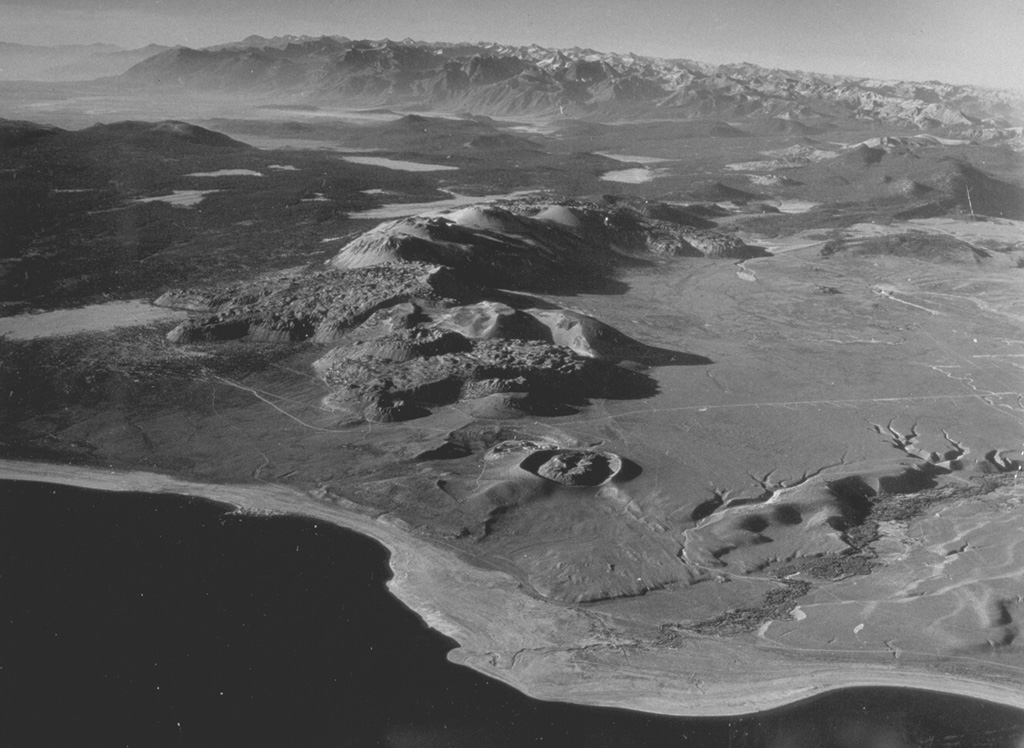
The Global Volcanism Program has no activity reports available for Mono-Inyo Craters.
The Global Volcanism Program has no Weekly Reports available for Mono-Inyo Craters.
The Global Volcanism Program has no Bulletin Reports available for Mono-Inyo Craters.
|
|
||||||||||||||||||||||||||||
There is data available for 13 confirmed Holocene eruptive periods.
1380 ± 50 years Confirmed Eruption (Explosive / Effusive)
| Episode 1 | Eruption (Explosive / Effusive) | Inyo Craters (S Deadman, Obsidian, Glass Creek) | |||
|---|---|---|---|---|
| 1380 ± 50 years - Unknown | Evidence from Isotopic: 14C (calibrated) | |||
1350 ± 20 years Confirmed Eruption (Explosive / Effusive) VEI: 4
| Episode 1 | Eruption (Explosive / Effusive) | Mono Craters (Panum Crater, nearby vents) | ||||||||||||||||||||||||||||||||||||||||||||||||||||||
|---|---|---|---|---|---|---|---|---|---|---|---|---|---|---|---|---|---|---|---|---|---|---|---|---|---|---|---|---|---|---|---|---|---|---|---|---|---|---|---|---|---|---|---|---|---|---|---|---|---|---|---|---|---|---|---|
| 1350 ± 20 years - Unknown | Evidence from Sidereal: Dendrochronology | ||||||||||||||||||||||||||||||||||||||||||||||||||||||
|
List of 9 Events for Episode 1 at Mono Craters (Panum Crater, nearby vents)
|
|||||||||||||||||||||||||||||||||||||||||||||||||||||||
1000 ± 200 years Confirmed Eruption (Explosive / Effusive)
| Episode 1 | Eruption (Explosive / Effusive) | Mono Craters (dome on NW edge of NW Coulee) | |||||||||||||||||||||||||||||
|---|---|---|---|---|---|---|---|---|---|---|---|---|---|---|---|---|---|---|---|---|---|---|---|---|---|---|---|---|---|---|
| 1000 ± 200 years - Unknown | Evidence from Chem/Bio: Hydration Rind | |||||||||||||||||||||||||||||
|
List of 4 Events for Episode 1 at Mono Craters (dome on NW edge of NW Coulee)
|
||||||||||||||||||||||||||||||
0620 ± 27 years Confirmed Eruption (Explosive / Effusive) VEI: 4
| Episode 1 | Eruption (Explosive / Effusive) | Southern Mono Craters (South Coulee area) | |||||||||||||||||||||||||||||||||||||||||||||||||||||||||||
|---|---|---|---|---|---|---|---|---|---|---|---|---|---|---|---|---|---|---|---|---|---|---|---|---|---|---|---|---|---|---|---|---|---|---|---|---|---|---|---|---|---|---|---|---|---|---|---|---|---|---|---|---|---|---|---|---|---|---|---|---|
| 0620 ± 27 years - Unknown | Evidence from Isotopic: 14C (calibrated) | |||||||||||||||||||||||||||||||||||||||||||||||||||||||||||
|
List of 10 Events for Episode 1 at Southern Mono Craters (South Coulee area)
|
||||||||||||||||||||||||||||||||||||||||||||||||||||||||||||
0490 ± 100 years Confirmed Eruption (Explosive / Effusive)
| Episode 1 | Eruption (Explosive / Effusive) | Mono Craters (NW Coulee and Pumice Pit dome) | |||||||||||||||||||||||||||||||||||||||
|---|---|---|---|---|---|---|---|---|---|---|---|---|---|---|---|---|---|---|---|---|---|---|---|---|---|---|---|---|---|---|---|---|---|---|---|---|---|---|---|---|
| 0490 ± 100 years - Unknown | Evidence from Isotopic: 14C (uncalibrated) | |||||||||||||||||||||||||||||||||||||||
|
List of 6 Events for Episode 1 at Mono Craters (NW Coulee and Pumice Pit dome)
|
||||||||||||||||||||||||||||||||||||||||
0440 ± 100 years Confirmed Eruption (Explosive / Effusive)
| Episode 1 | Eruption (Explosive / Effusive) | Southern Mono Craters | ||||||||||||||||||||||||
|---|---|---|---|---|---|---|---|---|---|---|---|---|---|---|---|---|---|---|---|---|---|---|---|---|---|
| 0440 ± 100 years - Unknown | Evidence from Isotopic: 14C (uncalibrated) | ||||||||||||||||||||||||
|
List of 3 Events for Episode 1 at Southern Mono Craters
|
|||||||||||||||||||||||||
0320 ± 200 years Confirmed Eruption (Explosive / Effusive)
| Episode 1 | Eruption (Explosive / Effusive) | Mono Craters (South Coulee?) | |||||||||||||||||||
|---|---|---|---|---|---|---|---|---|---|---|---|---|---|---|---|---|---|---|---|---|
| 0320 ± 200 years - Unknown | Evidence from Isotopic: 14C (calibrated) | |||||||||||||||||||
|
List of 2 Events for Episode 1 at Mono Craters (South Coulee?)
|
||||||||||||||||||||
0290 ± 50 years Confirmed Eruption (Explosive / Effusive)
| Episode 1 | Eruption (Explosive / Effusive) | Inyo Craters (Wilson Butte) | |||
|---|---|---|---|---|
| 0290 ± 50 years - Unknown | Evidence from Isotopic: 14C (calibrated) | |||
0010 ± 200 years Confirmed Eruption (Explosive / Effusive)
| Episode 1 | Eruption (Explosive / Effusive) | Mono Craters (South Coulee?) | |||||||||||||||||||
|---|---|---|---|---|---|---|---|---|---|---|---|---|---|---|---|---|---|---|---|---|
| 0010 ± 200 years - Unknown | Evidence from Isotopic: 14C (calibrated) | |||||||||||||||||||
|
List of 2 Events for Episode 1 at Mono Craters (South Coulee?)
|
||||||||||||||||||||
0700 BCE ± 800 years Confirmed Eruption (Explosive / Effusive)
| Episode 1 | Eruption (Explosive / Effusive) | Central Mono Craters | ||||||||||||||
|---|---|---|---|---|---|---|---|---|---|---|---|---|---|---|---|
| 0700 BCE ± 800 years - Unknown | Evidence from Chem/Bio: Hydration Rind | ||||||||||||||
|
List of 1 Events for Episode 1 at Central Mono Craters
|
|||||||||||||||
3850 BCE ± 1160 years Confirmed Eruption (Explosive / Effusive)
| Episode 1 | Eruption (Explosive / Effusive) | Mono Craters (crater N of Punchbowl) | |||
|---|---|---|---|---|
| 3850 BCE ± 1160 years - Unknown | Evidence from Chem/Bio: Hydration Rind | |||
4050 BCE (?) Confirmed Eruption (Explosive / Effusive)
| Episode 1 | Eruption (Explosive / Effusive) | Inyo Craters (N of Deadman Creek) | |||
|---|---|---|---|---|
| 4050 BCE (?) - Unknown | Evidence from Chem/Bio: Hydration Rind | |||
6750 BCE ± 1740 years Confirmed Eruption (Explosive / Effusive)
| Episode 1 | Eruption (Explosive / Effusive) | Mono Craters (Punchbowl) | ||||||||||||||
|---|---|---|---|---|---|---|---|---|---|---|---|---|---|---|---|
| 6750 BCE ± 1740 years - Unknown | Evidence from Chem/Bio: Hydration Rind | ||||||||||||||
|
List of 1 Events for Episode 1 at Mono Craters (Punchbowl)
|
|||||||||||||||
This compilation of synonyms and subsidiary features may not be comprehensive. Features are organized into four major categories: Cones, Craters, Domes, and Thermal Features. Synonyms of features appear indented below the primary name. In some cases additional feature type, elevation, or location details are provided.
Cones |
||||
| Feature Name | Feature Type | Elevation | Latitude | Longitude |
| Deer Mountain | Cone | 2677 m | 37° 41' 52.00" N | 119° 0' 47.00" W |
Craters |
||||
| Feature Name | Feature Type | Elevation | Latitude | Longitude |
| Amphitheater Crater | Crater | |||
| Inyo Craters | Crater | 2508 m | 37° 41' 33.00" N | 119° 0' 42.00" W |
| Mono Craters | Crater - Cone | 2779 m | 37° 51' 46.00" N | 119° 0' 26.00" W |
| West Control Crater | Crater | |||
Domes |
||||
| Feature Name | Feature Type | Elevation | Latitude | Longitude |
| Crater Mountain | Dome | 2772 m | 37° 52' 40.00" N | 119° 0' 25.00" W |
| Cratered Dome | Dome | 2124 m | 37° 55' 22.00" N | 119° 1' 40.00" W |
| Deadman Creek | Dome | 2570 m | 37° 43' 0.00" N | 119° 1' 0.00" W |
| Glass Creek | Dome | 2629 m | 37° 45' 0.00" N | 119° 1' 0.00" W |
| North Coulee | Dome | 2583 m | 37° 53' 28.00" N | 119° 1' 0.00" W |
| North Deadman Creek | Dome | 2549 m | 37° 43' 0.00" N | 119° 1' 0.00" W |
| Obsidian | Dome | 2603 m | 37° 45' 33.00" N | 119° 1' 15.00" W |
| Panum | Dome | 2127 m | 37° 55' 46.00" N | 119° 2' 42.00" W |
| Pumice Pit Dome | Dome | 2046 m | 37° 55' 34.00" N | 119° 2' 24.00" W |
| Punchbowl | Dome | 2437 m | 37° 49' 2.00" N | 119° 1' 18.00" W |
| South Coulee | Dome | 2691 m | 37° 51' 0.00" N | 119° 1' 0.00" W |
| Upper Dome | Dome | 2257 m | 37° 55' 2.00" N | 119° 2' 7.00" W |
| Wilson Butte | Dome | 2564 m | 37° 46' 55.00" N | 119° 1' 34.00" W |
 The Mono Craters volcanic field, between Mono Lake in the foreground and Long Valley caldera at the upper left, is a 17-km-long chain of rhyolitic lava domes and thick, viscous lava flows. Mono Craters have been frequently active during the Holocene. Panum crater (the vent nearest to Mono Lake), is partially filled by a lava dome and was the site of the latest eruption from Mono Craters, about 600 years ago.
The Mono Craters volcanic field, between Mono Lake in the foreground and Long Valley caldera at the upper left, is a 17-km-long chain of rhyolitic lava domes and thick, viscous lava flows. Mono Craters have been frequently active during the Holocene. Panum crater (the vent nearest to Mono Lake), is partially filled by a lava dome and was the site of the latest eruption from Mono Craters, about 600 years ago. 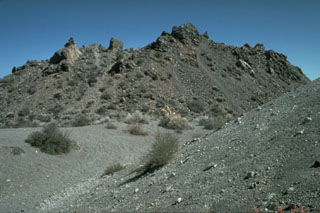 The hackly surfaced Panum lava dome, filling a tephra ring at the northern end of the Mono Craters chain, was one of five rhyolitic lava domes and flows emplaced at the end of a major eruption about 600 years ago. The eruption, which began with powerful plinian explosive eruptions accompanied by pyroclastic flows and surges, occurred just a year or two prior to another major eruption at Inyo Craters to the south.
The hackly surfaced Panum lava dome, filling a tephra ring at the northern end of the Mono Craters chain, was one of five rhyolitic lava domes and flows emplaced at the end of a major eruption about 600 years ago. The eruption, which began with powerful plinian explosive eruptions accompanied by pyroclastic flows and surges, occurred just a year or two prior to another major eruption at Inyo Craters to the south.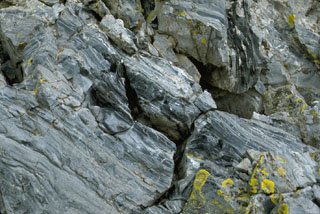 Flow-banded rhyolitic obsidian of the Panum Crater lava dome was erupted about 600 years ago at the northern end of the Mono Craters. The greenish-yellow areas are lichens on the surface of the dome.
Flow-banded rhyolitic obsidian of the Panum Crater lava dome was erupted about 600 years ago at the northern end of the Mono Craters. The greenish-yellow areas are lichens on the surface of the dome.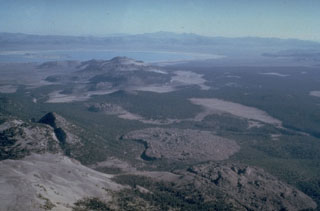 The Mono Craters volcanic field south of Mono Lake at the upper left, is a 17-km-long arcuate chain of rhyolitic lava domes and thick, viscous lava flows. Mono Craters has been frequently active throughout the Holocene, along with the Inyo Craters chain to the south. The Inyo Craters chain, which includes the Wilson Butte, Obsidian and Glass Creek domes, which are oriented diagonally along a N-S line from the left center to lower right of the photo. The latest eruptions of Mono Craters and Inyo Craters occurred nearly simultaneously around 600 years ago.
The Mono Craters volcanic field south of Mono Lake at the upper left, is a 17-km-long arcuate chain of rhyolitic lava domes and thick, viscous lava flows. Mono Craters has been frequently active throughout the Holocene, along with the Inyo Craters chain to the south. The Inyo Craters chain, which includes the Wilson Butte, Obsidian and Glass Creek domes, which are oriented diagonally along a N-S line from the left center to lower right of the photo. The latest eruptions of Mono Craters and Inyo Craters occurred nearly simultaneously around 600 years ago.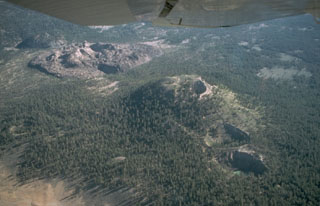 An aerial view from the south shows the North and South Inyo Craters phreatic explosion craters diagonally cutting forested Deer Mountain from the right center to lower right, and the unvegetated South Deadman lava dome and obsidian flow and the forested mound of North Deadman dome at the upper left. Eruption of magmatic tephra and the formation of the phreatic explosion craters preceded emplacement of the lava domes and flows about 600 years ago.
An aerial view from the south shows the North and South Inyo Craters phreatic explosion craters diagonally cutting forested Deer Mountain from the right center to lower right, and the unvegetated South Deadman lava dome and obsidian flow and the forested mound of North Deadman dome at the upper left. Eruption of magmatic tephra and the formation of the phreatic explosion craters preceded emplacement of the lava domes and flows about 600 years ago.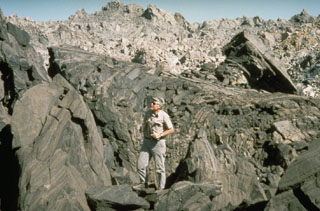 The Obsidian Flow, a lava flow with a hackly surface showing prominent flow banding, was erupted at the northern end of a chain of lava domes and flows during a dike-fed eruption about 600 years ago at Inyo Craters. The Obsidian Flow was the largest of four flows and domes emplaced during this eruption.
The Obsidian Flow, a lava flow with a hackly surface showing prominent flow banding, was erupted at the northern end of a chain of lava domes and flows during a dike-fed eruption about 600 years ago at Inyo Craters. The Obsidian Flow was the largest of four flows and domes emplaced during this eruption.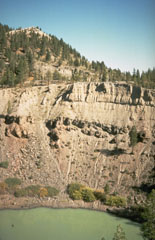 South Inyo Crater, one of a chain of small phreatic explosion craters at the southern end of the Inyo Craters chain of lava domes and flows, is partially filled by a shallow lake. The 200-m-wide South Inyo Crater was formed when groundwater interacted with magma from a shallow dike. That interaction fed a powerful explosive eruption that concluded with the emplacement of obsidian lava domes and flows to the north of this crater.
South Inyo Crater, one of a chain of small phreatic explosion craters at the southern end of the Inyo Craters chain of lava domes and flows, is partially filled by a shallow lake. The 200-m-wide South Inyo Crater was formed when groundwater interacted with magma from a shallow dike. That interaction fed a powerful explosive eruption that concluded with the emplacement of obsidian lava domes and flows to the north of this crater.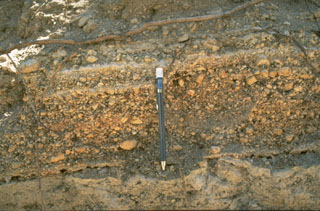 The Mono-Inyo craters produced explosive eruptions and effusive lava flows. The pumice layers above the bottom of the pen originated from the South Deadman vent of Inyo Craters about 600 years ago. Interbedded finer layers record brief pauses during the course of the eruption.
The Mono-Inyo craters produced explosive eruptions and effusive lava flows. The pumice layers above the bottom of the pen originated from the South Deadman vent of Inyo Craters about 600 years ago. Interbedded finer layers record brief pauses during the course of the eruption.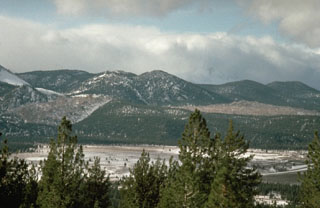 The unvegetated Glass Creek lava flow on the left and Obsidian Flow on the right are among a group of obsidian lava flows and domes that were emplaced during a major eruption from the Inyo Craters about 600 years ago. The eruption, originating from a shallow dike, began with powerful explosive activity, pyroclastic flows, and a series of phreatic explosions, and ended with effusion of the lava domes and flows.
The unvegetated Glass Creek lava flow on the left and Obsidian Flow on the right are among a group of obsidian lava flows and domes that were emplaced during a major eruption from the Inyo Craters about 600 years ago. The eruption, originating from a shallow dike, began with powerful explosive activity, pyroclastic flows, and a series of phreatic explosions, and ended with effusion of the lava domes and flows.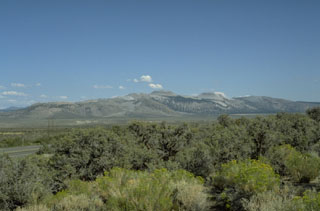 The Mono Craters volcanic field, seen here from the NW, is a 17-km-long arcuate chain of lava domes, lava flows, and tephra rings. The latest eruptions took place about 600 years ago from several vents at the northern end of the chain, producing rhyolitic lava domes and flows.
The Mono Craters volcanic field, seen here from the NW, is a 17-km-long arcuate chain of lava domes, lava flows, and tephra rings. The latest eruptions took place about 600 years ago from several vents at the northern end of the chain, producing rhyolitic lava domes and flows.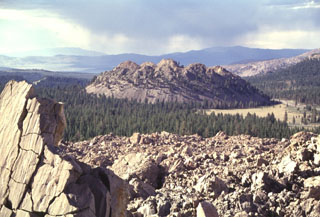 Wilson Butte, the northermost lava dome of the Inyo Craters, is seen from the Obsidian Flow lava dome to the south. The Inyo Craters are a 12-km-long chain of silicic lava domes, lava flows, and explosion craters along the eastern margin of Sierra Nevada south of Mono Craters near the town of Mammoth. Inyo Craters overtop the NW rim of the Pleistocene Long Valley caldera and extend onto the caldera floor, but are chemically and magmatically part of a different volcanic system. The latest eruptions at Inyo Craters took place about 600 years ago.
Wilson Butte, the northermost lava dome of the Inyo Craters, is seen from the Obsidian Flow lava dome to the south. The Inyo Craters are a 12-km-long chain of silicic lava domes, lava flows, and explosion craters along the eastern margin of Sierra Nevada south of Mono Craters near the town of Mammoth. Inyo Craters overtop the NW rim of the Pleistocene Long Valley caldera and extend onto the caldera floor, but are chemically and magmatically part of a different volcanic system. The latest eruptions at Inyo Craters took place about 600 years ago.The following 51 samples associated with this volcano can be found in the Smithsonian's NMNH Department of Mineral Sciences collections, and may be availble for research (contact the Rock and Ore Collections Manager). Catalog number links will open a window with more information.
| Catalog Number | Sample Description | Lava Source | Collection Date |
|---|---|---|---|
| NMNH 111123-59 | Rhyolitic Pumice | -- | -- |
| NMNH 111123-60 | Rhyolitic Obsidian | -- | -- |
| NMNH 115401-1 | Obsidian | -- | -- |
| NMNH 117460-1 | Obsidian | South Mono Dome | -- |
| NMNH 117460-10 | Obsidian | Dome 8913 | -- |
| NMNH 117460-11 | Obsidian | -- | -- |
| NMNH 117460-12 | Obsidian | Dome 8913 | -- |
| NMNH 117460-13 | Obsidian | -- | -- |
| NMNH 117460-14 | Obsidian | -- | -- |
| NMNH 117460-15 | Pumice | -- | -- |
| NMNH 117460-16 | Obsidian | -- | -- |
| NMNH 117460-17 | Pumice | -- | -- |
| NMNH 117460-18 | Pumice | -- | -- |
| NMNH 117460-19 | Pumice | -- | -- |
| NMNH 117460-2 | Pumice | South Mono Dome | -- |
| NMNH 117460-20 | Obsidian | -- | -- |
| NMNH 117460-21 | Obsidian | Panum Dome | -- |
| NMNH 117460-22 | Perlite | -- | -- |
| NMNH 117460-23 | Obsidian | Panum Dome | -- |
| NMNH 117460-24 | Obsidian | Panum Dome | -- |
| NMNH 117460-25 | Glass | Panum Dome | -- |
| NMNH 117460-26 | Pumice | Panum Dome | -- |
| NMNH 117460-27 | Pumice | Panum Dome | -- |
| NMNH 117460-28 | Pumice | Dome 8913 | -- |
| NMNH 117460-29 | Obsidian | Dome 8913 | -- |
| NMNH 117460-3 | Glass | Dome 8139 | -- |
| NMNH 117460-4 | Obsidian | Dome 8139 | -- |
| NMNH 117460-5 | Obsidian | Dome 8139 | -- |
| NMNH 117460-6 | Pumice | -- | -- |
| NMNH 117460-7 | Obsidian | -- | -- |
| NMNH 117460-8 | Pumice | -- | -- |
| NMNH 117460-9 | Obsidian | Dome 8913 | -- |
| NMNH 22898 | Obsidian | -- | -- |
| NMNH 29631-1 | Obsidian | -- | -- |
| NMNH 29631-2 | Obsidian | -- | -- |
| NMNH 29631-3 | Liparite | -- | -- |
| NMNH 29631-4 | Obsidian | -- | -- |
| NMNH 29631-5 | Hyalo Liparite | -- | -- |
| NMNH 29631-6 | Hyalo Liparite | -- | -- |
| NMNH 29633 | Lapilli | -- | -- |
| NMNH 35271 | Obsidian | -- | -- |
| NMNH 35272-1 | Obsidian | -- | -- |
| NMNH 35272-2 | Obsidian | -- | -- |
| NMNH 35273 | Obsidian | -- | -- |
| NMNH 37209 | Pumice | -- | -- |
| NMNH 37210 | Pumice | -- | -- |
| NMNH 37211 | Pumice | -- | -- |
| NMNH 37211-1 | Pumice | -- | -- |
| NMNH 37211-2 | Pumice | -- | -- |
| NMNH 37216 | Hypersthene Andesite | -- | -- |
| NMNH 76718 | Tufa | -- | -- |
| Copernicus Browser | The Copernicus Browser replaced the Sentinel Hub Playground browser in 2023, to provide access to Earth observation archives from the Copernicus Data Space Ecosystem, the main distribution platform for data from the EU Copernicus missions. |
| MIROVA | Middle InfraRed Observation of Volcanic Activity (MIROVA) is a near real time volcanic hot-spot detection system based on the analysis of MODIS (Moderate Resolution Imaging Spectroradiometer) data. In particular, MIROVA uses the Middle InfraRed Radiation (MIR), measured over target volcanoes, in order to detect, locate and measure the heat radiation sourced from volcanic activity. |
| MODVOLC Thermal Alerts | Using infrared satellite Moderate Resolution Imaging Spectroradiometer (MODIS) data, scientists at the Hawai'i Institute of Geophysics and Planetology, University of Hawai'i, developed an automated system called MODVOLC to map thermal hot-spots in near real time. For each MODIS image, the algorithm automatically scans each 1 km pixel within it to check for high-temperature hot-spots. When one is found the date, time, location, and intensity are recorded. MODIS looks at every square km of the Earth every 48 hours, once during the day and once during the night, and the presence of two MODIS sensors in space allows at least four hot-spot observations every two days. Each day updated global maps are compiled to display the locations of all hot spots detected in the previous 24 hours. There is a drop-down list with volcano names which allow users to 'zoom-in' and examine the distribution of hot-spots at a variety of spatial scales. |
|
WOVOdat
Single Volcano View Temporal Evolution of Unrest Side by Side Volcanoes |
WOVOdat is a database of volcanic unrest; instrumentally and visually recorded changes in seismicity, ground deformation, gas emission, and other parameters from their normal baselines. It is sponsored by the World Organization of Volcano Observatories (WOVO) and presently hosted at the Earth Observatory of Singapore.
GVMID Data on Volcano Monitoring Infrastructure The Global Volcano Monitoring Infrastructure Database GVMID, is aimed at documenting and improving capabilities of volcano monitoring from the ground and space. GVMID should provide a snapshot and baseline view of the techniques and instrumentation that are in place at various volcanoes, which can be use by volcano observatories as reference to setup new monitoring system or improving networks at a specific volcano. These data will allow identification of what monitoring gaps exist, which can be then targeted by remote sensing infrastructure and future instrument deployments. |
| Volcanic Hazard Maps | The IAVCEI Commission on Volcanic Hazards and Risk has a Volcanic Hazard Maps database designed to serve as a resource for hazard mappers (or other interested parties) to explore how common issues in hazard map development have been addressed at different volcanoes, in different countries, for different hazards, and for different intended audiences. In addition to the comprehensive, searchable Volcanic Hazard Maps Database, this website contains information about diversity of volcanic hazard maps, illustrated using examples from the database. This site is for educational purposes related to volcanic hazard maps. Hazard maps found on this website should not be used for emergency purposes. For the most recent, official hazard map for a particular volcano, please seek out the proper institutional authorities on the matter. |
| IRIS seismic stations/networks | Incorporated Research Institutions for Seismology (IRIS) Data Services map showing the location of seismic stations from all available networks (permanent or temporary) within a radius of 0.18° (about 20 km at mid-latitudes) from the given location of Mono-Inyo Craters. Users can customize a variety of filters and options in the left panel. Note that if there are no stations are known the map will default to show the entire world with a "No data matched request" error notice. |
| UNAVCO GPS/GNSS stations | Geodetic Data Services map from UNAVCO showing the location of GPS/GNSS stations from all available networks (permanent or temporary) within a radius of 20 km from the given location of Mono-Inyo Craters. Users can customize the data search based on station or network names, location, and time window. Requires Adobe Flash Player. |
| DECADE Data | The DECADE portal, still in the developmental stage, serves as an example of the proposed interoperability between The Smithsonian Institution's Global Volcanism Program, the Mapping Gas Emissions (MaGa) Database, and the EarthChem Geochemical Portal. The Deep Earth Carbon Degassing (DECADE) initiative seeks to use new and established technologies to determine accurate global fluxes of volcanic CO2 to the atmosphere, but installing CO2 monitoring networks on 20 of the world's 150 most actively degassing volcanoes. The group uses related laboratory-based studies (direct gas sampling and analysis, melt inclusions) to provide new data for direct degassing of deep earth carbon to the atmosphere. |
| Large Eruptions of Mono-Inyo Craters | Information about large Quaternary eruptions (VEI >= 4) is cataloged in the Large Magnitude Explosive Volcanic Eruptions (LaMEVE) database of the Volcano Global Risk Identification and Analysis Project (VOGRIPA). |
| EarthChem | EarthChem develops and maintains databases, software, and services that support the preservation, discovery, access and analysis of geochemical data, and facilitate their integration with the broad array of other available earth science parameters. EarthChem is operated by a joint team of disciplinary scientists, data scientists, data managers and information technology developers who are part of the NSF-funded data facility Integrated Earth Data Applications (IEDA). IEDA is a collaborative effort of EarthChem and the Marine Geoscience Data System (MGDS). |